Nanoscale Mechanical and Morphological Characterization of Ebolavirus-like Particles: Implications for Therapeutic Development
Abstract
1. Introduction
2. Results
2.1. Physical Conformation of the Samples
2.2. Elastic Modulus of the Samples
3. Discussion
3.1. Physical Conformation of the Samples
3.2. Elastic Modulus of the Samples
4. Materials and Methods
4.1. Virion Production and Hypothetical Conformation
4.2. AFM Specifications
4.3. AFM PeakForce Tapping® Imaging
4.4. Contact Mode Force Spectroscopy Nanoindentation
4.5. Single-Molecule Force Spectroscopy
5. Conclusions
Supplementary Materials
Author Contributions
Funding
Data Availability Statement
Acknowledgments
Conflicts of Interest
Abbreviations
| AFM | Atomic Force Microscopy |
| EBOV | Ebolavirus |
| VLP | Virus-Like Virion |
| GP | Glycoprotein |
| PS | Phosphatidylserine |
| rVSV-EBOV-GP | Recombinant Vesicular Stomatitis Virus Transfected with EBOV Glycoproteins |
| EBOVVP30 | UV-Inactivated Ebolavirus with the VP30 Segment of the RNA Sequence Replaced with Neomycin. |
| EBOV-VLP | Ebola Virus-Like Particles Obtained from IBT Bioservices in 2022 |
Appendix A. Supplemental Methods and Materials
Appendix A.1. PeakForce Tapping® Imaging
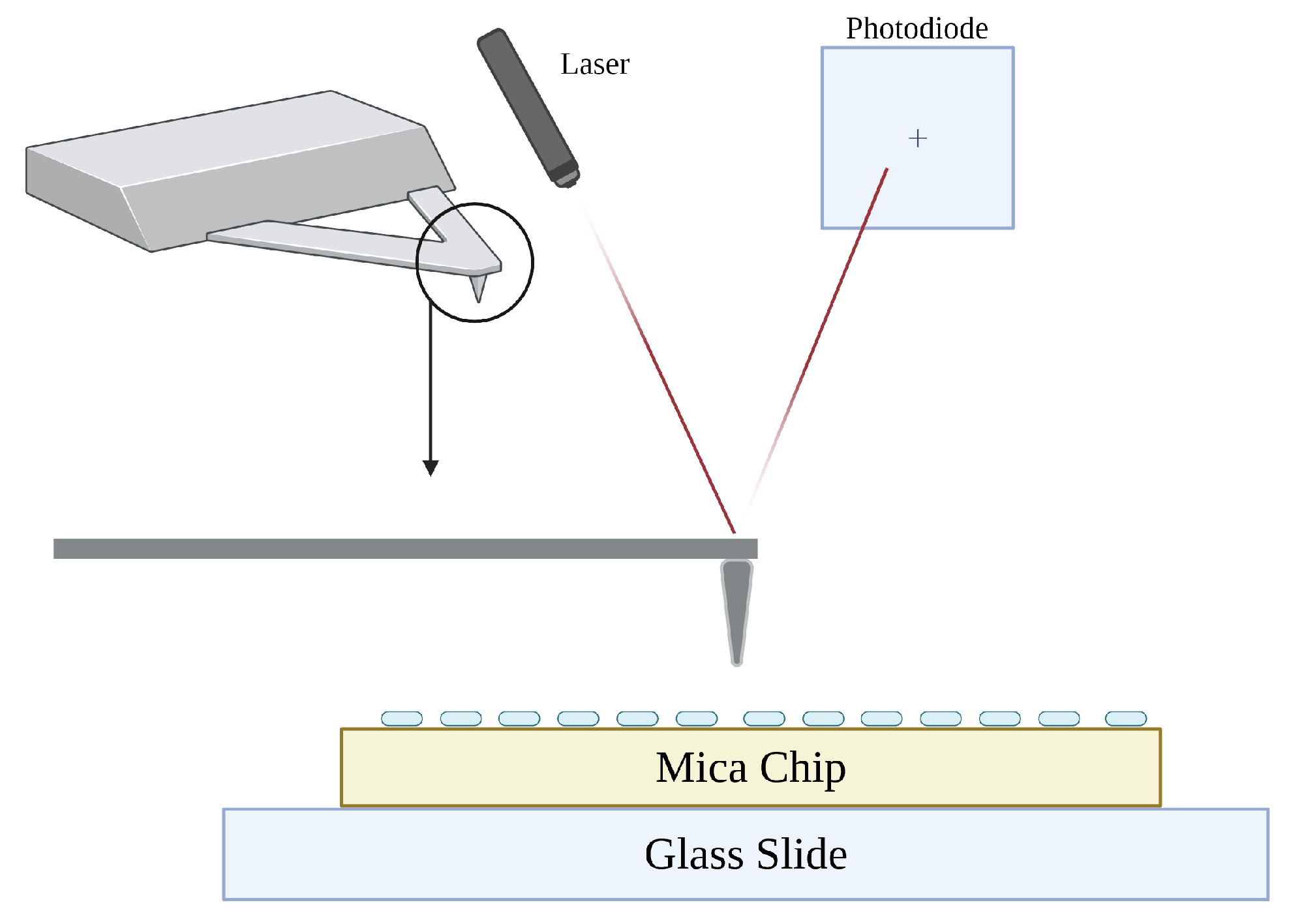
Appendix A.2. Contact Mode Force Spectroscopy Nanoindentation
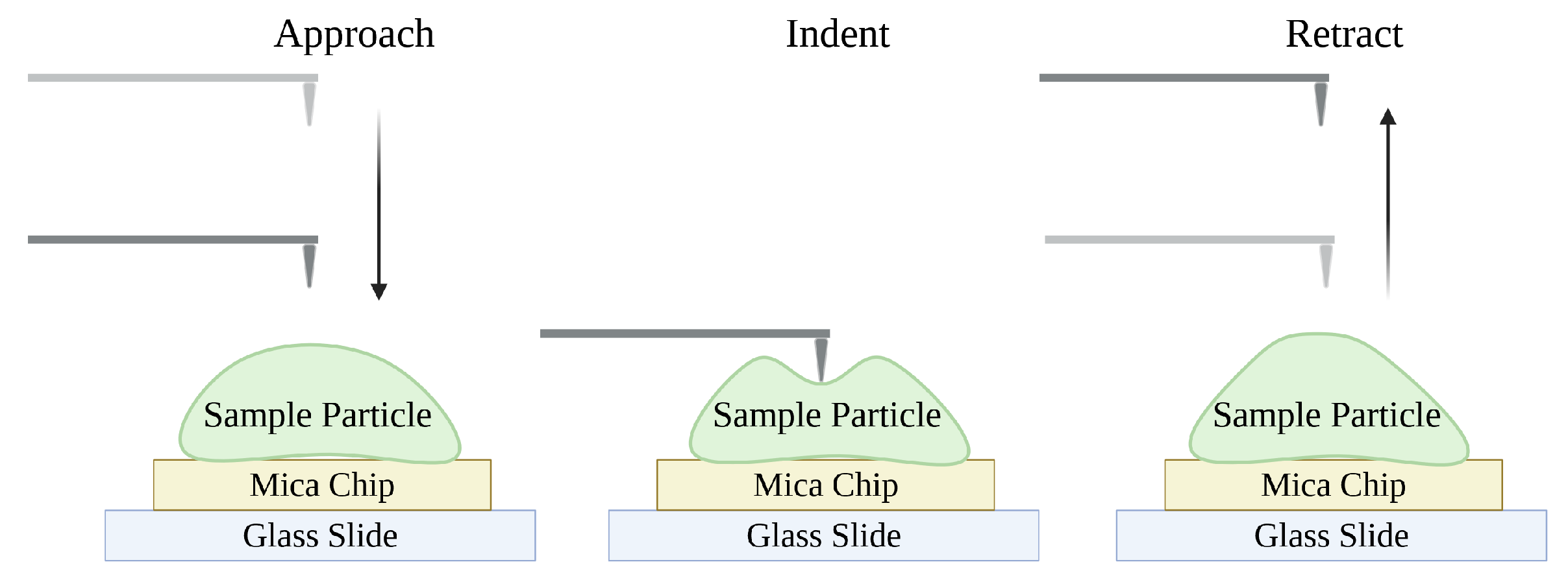
Appendix A.3. Uniformity of Elastic Modulus Across Viral Preparations
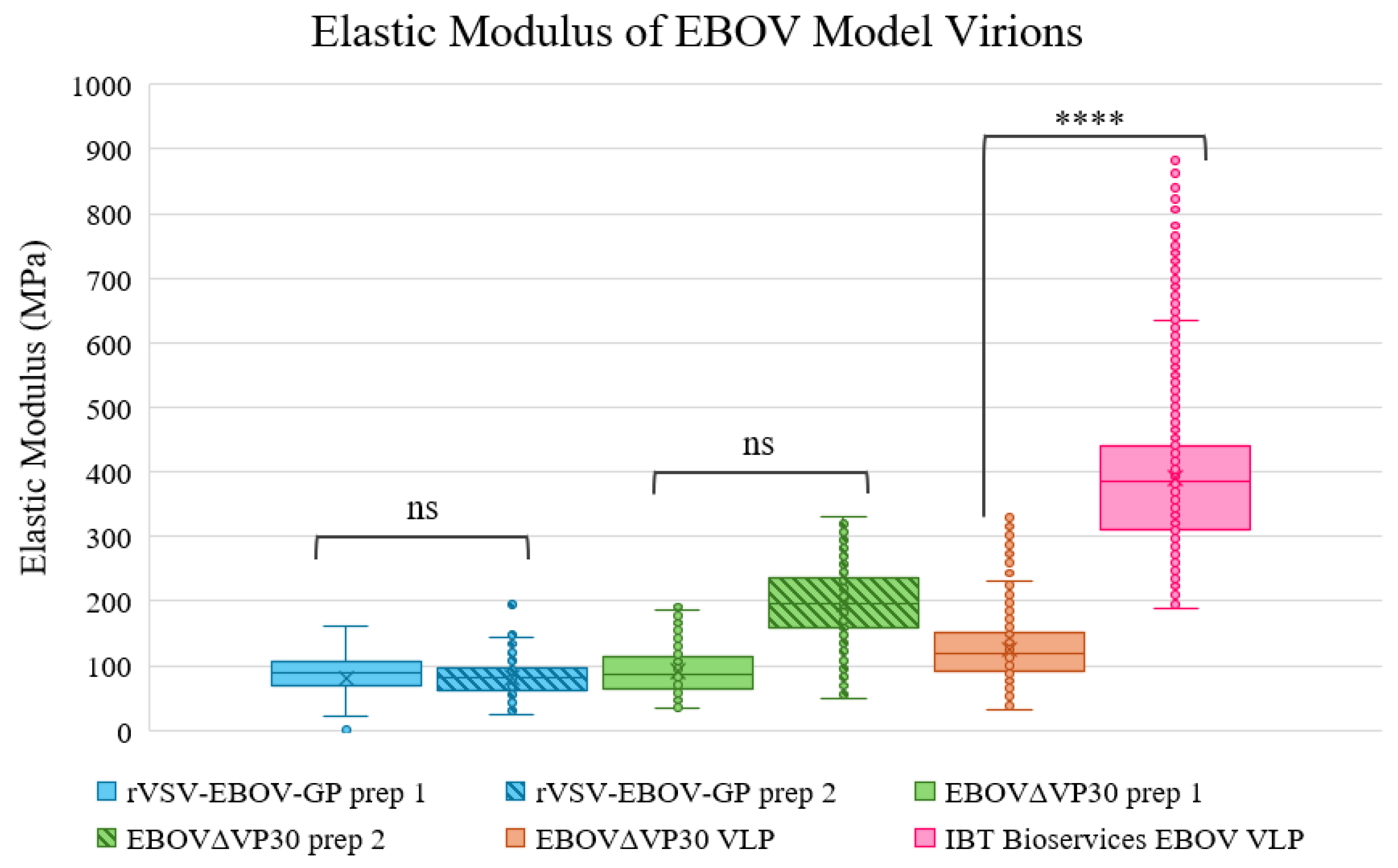
Appendix A.4. Single-Molecule Force Spectroscopy

| Sample | Adhesion Force (pN) | Adhesion Frequency (%) |
|---|---|---|
| Mica + Poly-L-lysine | 17.9 ± 1.9 | 6.1% |
| EBOVVP30 | 58.0 ± 24.5 | 12.1% |
| rVSV- EBOV-GP | 85.2 ± 51.2 | 16.2% |
| Sf9 EBOV VLP | 62.9 ± 33.9 | 18.6% |
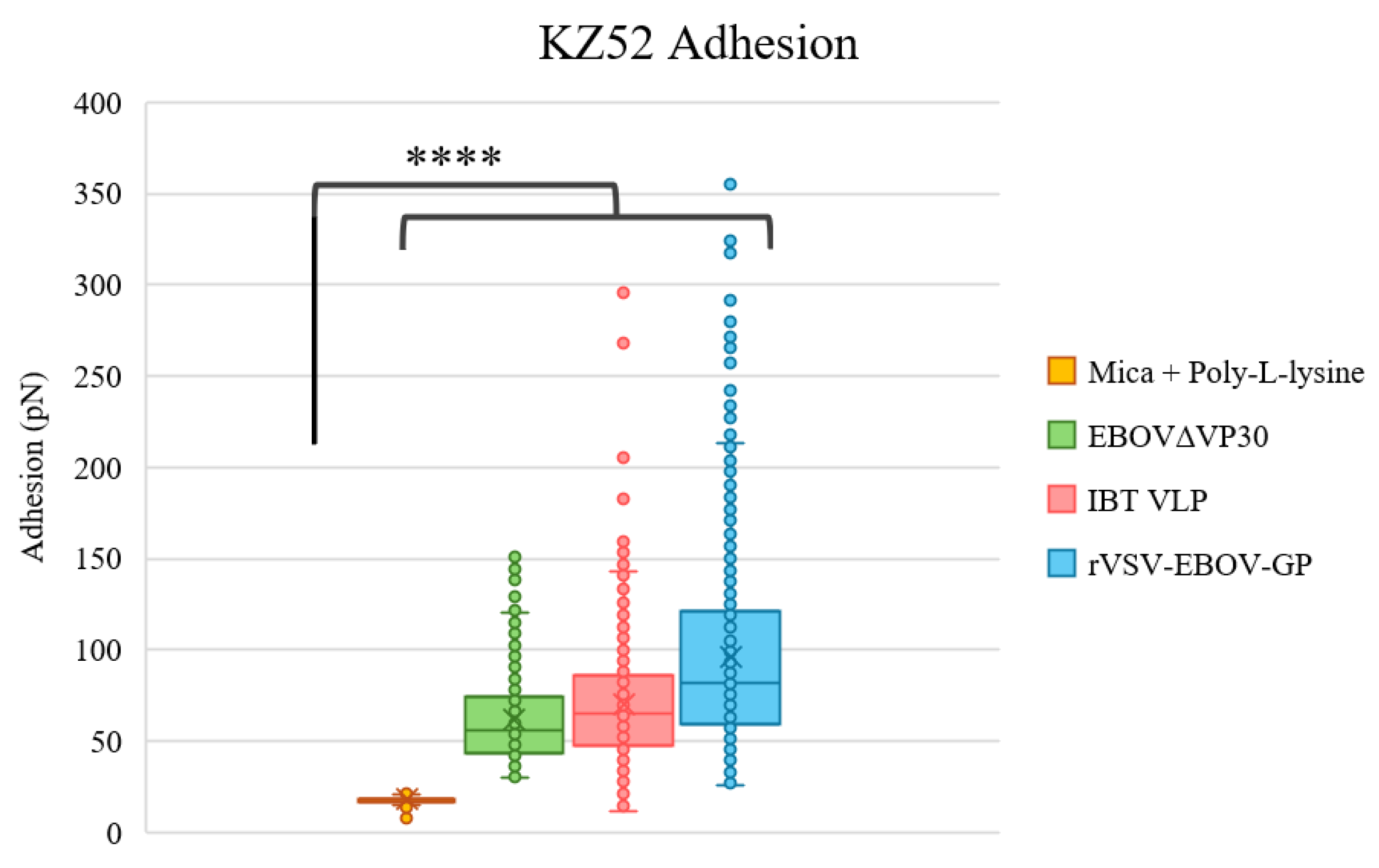

Appendix A.5. Sample Preparation
Appendix A.6. Explanation of Topographical Measurements
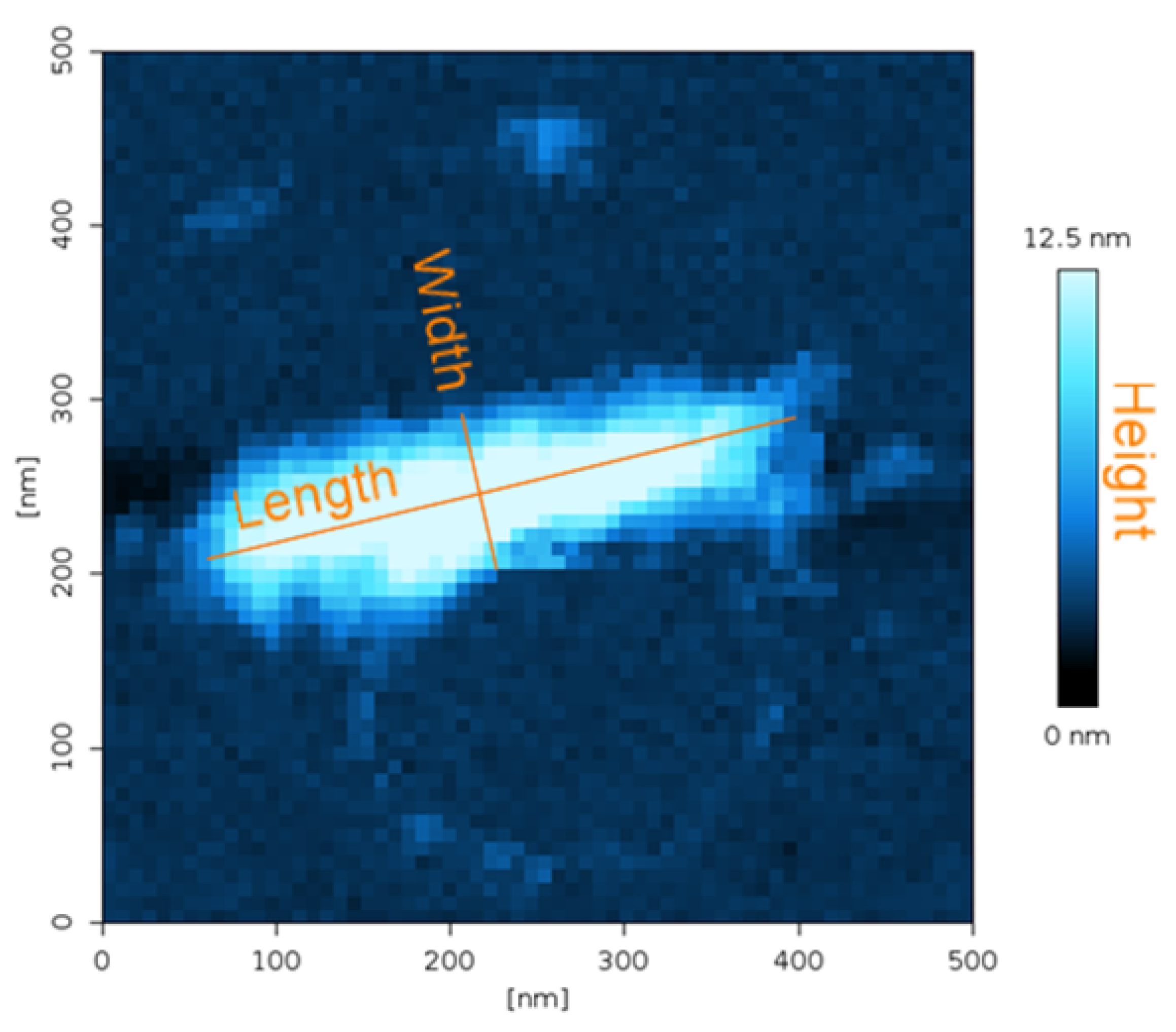
Appendix A.7. Acknowledgement of the Repulsive Electrical Double Layer Effect
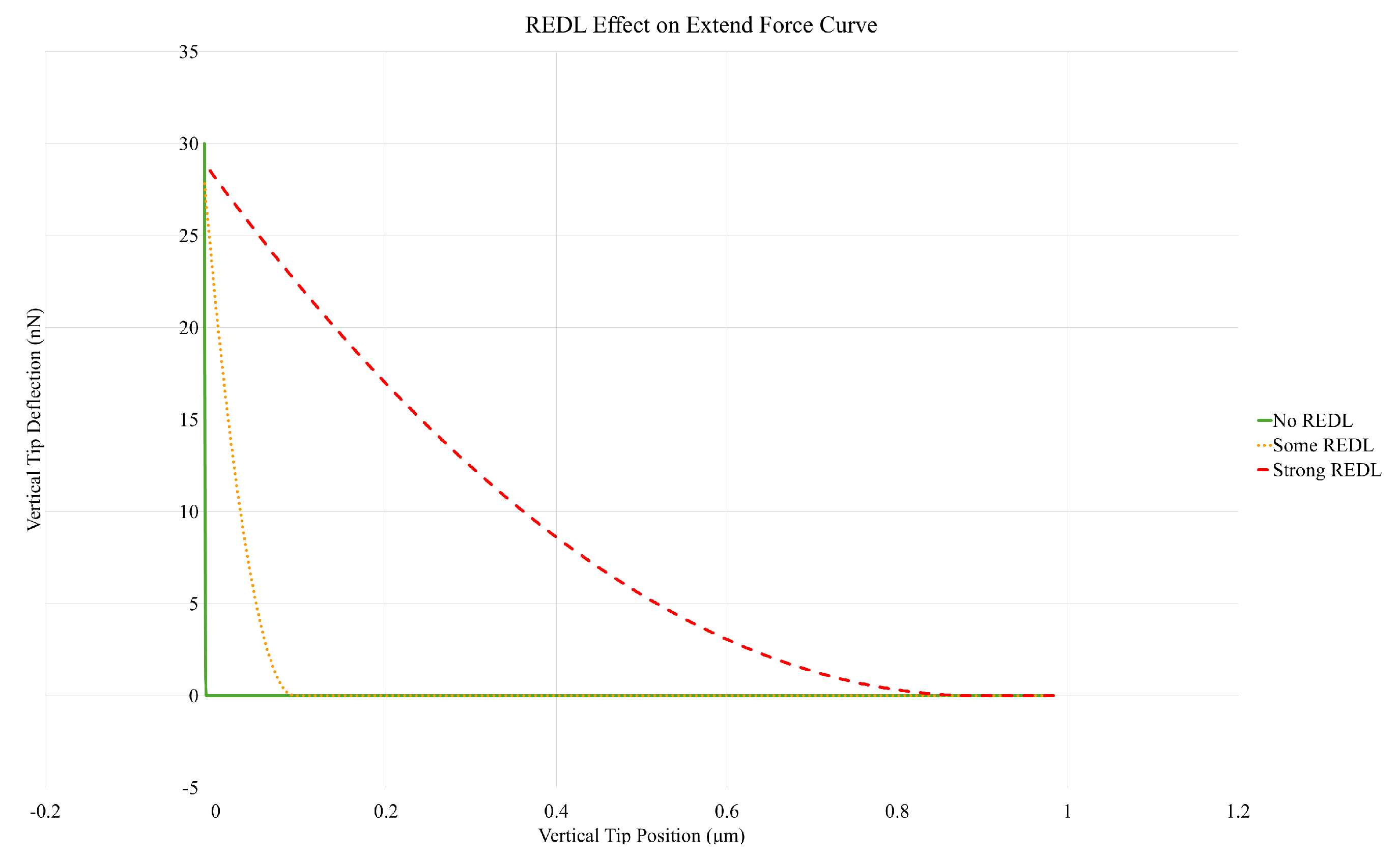
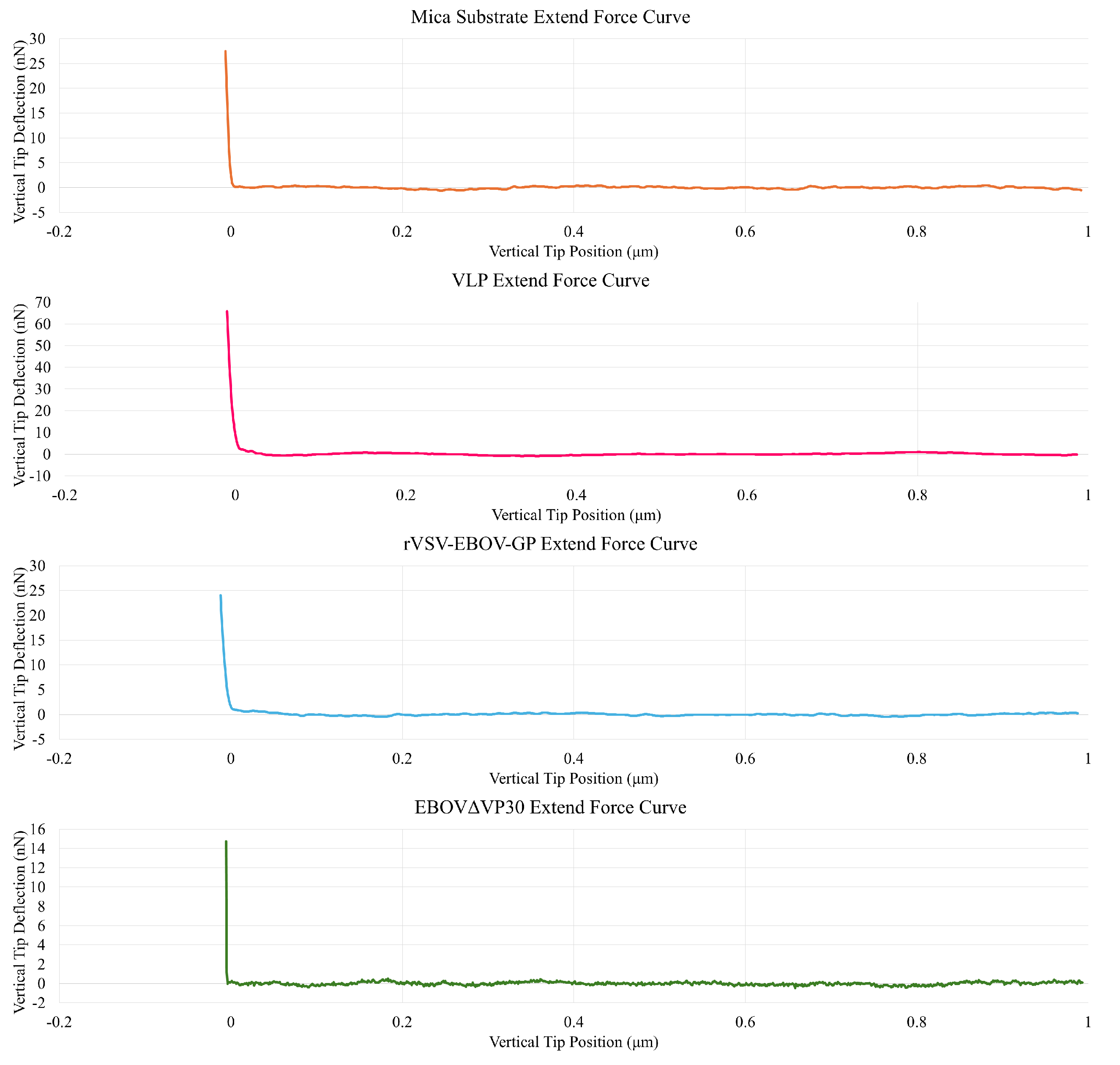
References
- Stahelin, R.V. Membrane binding and bending in Ebola VP40 assembly and egress. Front. Microbiol. 2014, 18, 300. [Google Scholar] [CrossRef]
- Jain, S.; Martynova, E.; Rizvanov, A.; Khaiboullina, S.; Baranwal, M. Structural and Functional Aspects of Ebola Virus Proteins. Pathogens 2021, 10, 1330. [Google Scholar] [CrossRef] [PubMed]
- Feldmann, H.; Geisbert, T. Ebola haemorrhagic fever. Lancet 2011, 377, 849–862. [Google Scholar] [CrossRef]
- Bharat, T.A.M.; Noda, T.; Riches, J.D.; Krarhling, V.; Kolesnikova, L.; Becker, S.; Kawaoka, Y.; Briggs, J.A.G. Structural dissection of Ebola virus and its assembly determinants using cryo-electron tomography. Proc. Natl. Acad. Sci. USA 2011, 109, 4275–4280. [Google Scholar] [CrossRef]
- Wu, Z.; Wang, C.; Li, Z.; Zhang, Y.; Zhang, X.E.; Cui, Z. Ebola Virus Uptake into Polarized Cells from the Apical Surface. MDPI Viruses 2019, 11, 1117. [Google Scholar] [CrossRef]
- Hasan, S.; Ahmad, S.A.; Masood, R.; Saeed, S. Ebola virus: A global public health menace: A narrative review. J. Family Med. Prim. Care 2019, 8, 2189–2201. [Google Scholar]
- Clarke, D.K.; Hendry, R.M.; Singh, V.; Rose, J.K.; Seligman, S.J.; Klug, B.; Kochhar, S.; Mac, L.M.; Carbery, B.; Chen, R.T. Live Virus Vaccines Based on a Vesicular Stomatitis Virus (VSV) Backbone: Standardized Template with Key Considerations for a Risk/Benefit Assessment. Vaccine 2016, 34, 6597–6609. [Google Scholar] [CrossRef]
- Fathi, A.; Dahlke, C.; Addo, M.M. Recombinant vesicular stomatitis virus vector vaccines for WHO blueprint priority pathogens. Hum. Vaccin. Immunother. 2019, 15, 2269–2285. [Google Scholar] [CrossRef]
- Monath, T.P.; Fast, P.E.; Modjarrad, K.; Clarke, D.K.; Martin, B.K.; Fusco, J.; Nichols, R.; Heppner, D.G.; Simon, J.K.; Dubey, S.; et al. rVSVΔG-ZEBOV-GP (also designated V920) recombinant vesicular stomatitis virus pseudotyped with Ebola Zaire Glycoprotein: Standardized template with key considerations for a risk/benefit assessment. Vaccine X 2019, 1, 100009. [Google Scholar] [CrossRef]
- Licata, J.M.; Johnson, R.F.; Han, Z.; Harty, R.N. Contribution of Ebola Virus Glycoprotein, Nucleoprotein, and VP24 to Budding of VP40 Virus-Like Particles. J. Virol. 2004, 78, 7344–7351. [Google Scholar] [CrossRef]
- Murphy, F.A. Public Health Image Library, ID #10815. 1976. Available online: https://phil.cdc.gov/details_linked.aspx?pid=10815 (accessed on 25 May 2025).
- Peng, W.; Rayaprolu, V.; Parvate, A.D.; Pronker, M.F.; Hui, S.; Parekh, D.; Shaffer, K.; Yu, X.; Saphire, E.O.; Snijder, J. Glycan shield of the ebolavirus envelope glycoprotein GP. Commun. Biol. 2022, 5, 785. [Google Scholar] [CrossRef] [PubMed]
- Newcomb, W.W.; Tobin, G.J.; McGowan, J.J.; Brown, J.C. In Vitro Reassembly of Vesicular Stomatitis Virus Skeletons. J. Virol. 1981, 41, 1055–1062. [Google Scholar] [CrossRef] [PubMed]
- Klenk, H.D.; Feldmann, H. Ebola and Marburg Viruses; Horizon Bioscience; Taylor & Francis: Abingdon-on-Thames, UK, 2003; p. 28. [Google Scholar]
- Witz, J.; Brown, F. Structural dynamics, an intrinsic property of viral capsids. Arch. Virol. 2001, 146, 2263–2274. [Google Scholar] [CrossRef] [PubMed]
- De Pablo, P.J.; Mateu, M.G. Mechanical Properties of Viruses. Sub-Cell. Biochem. 2024, 105, 629–691. [Google Scholar]
- Zhao, Y.; Ge, Z.; Fang, J. Elastic modulus of viral nanotubes. Phys. Rev. E 2008, 78, 031914. [Google Scholar] [CrossRef] [PubMed]
- Magazzu, A.; Marcuello, C. Investigation of Soft Matter Nanomechanics by Atomic Force Microscopy and Optical Tweezers: A Comprehensive Review. Nanomaterials 2023, 13, 963. [Google Scholar] [CrossRef]
- Nonn, A.; Kiss, B.; Pezeshkian, W.; Tancogne-Dejean, T.; Cerrone, A.; Kellermayer, M.; Bai, Y.; Li, W.; Wierzbicki, T. Inferring mechanical properties of the SARS-CoV-2 virus particle with nano-indentation tests and numerical simulations. J. Mech. Behav. Biomed. Mater. 2023, 148, 106153. [Google Scholar] [CrossRef]
- Martinez, M.J.; Volchkova, V.A.; Raoul, H.; Alazard-Dany, N.; Reynard, O.; Volchkov, V.E. Role of VP30 Phosphorylation in the Ebola Virus Replication Cycle. J. Inf. Dis. 2011, 204, S934–S940. [Google Scholar] [CrossRef]
- Halfmann, P.; Kim, J.H.; Ebihara, H.; Noda, T.; Neumann, G.; Feldmann, H.; Kawaoka, Y. Generation of biologically contained Ebola viruses. Proc. Natl. Acad. Sci. USA 2008, 105, 1129–1133. [Google Scholar] [CrossRef]
- Saphire, E.O. A Vaccine against Ebola Virus. Cell 2020, 181, 6. [Google Scholar] [CrossRef]
- Garbutt, M.; Liebscher, R.; Wahl-Jensen, V.; Jones, S.; Moller, P.; Wagner, R.; Volchkov, V.; Klenk, H.D.; Feldmann, H.; Stroher, U. Properties of Replication-Competent Vesicular Stomatitus Virsu Vectors Expressing Glycoproteins of Filoviruses and Arenaviruses. J. Virol. 2004, 78. [Google Scholar] [CrossRef] [PubMed]
- Brouillette, R.B.; Maury, W. Production of Filivirus Glycoprotein-Pseudotyped Vesicular Stomatitis for Study of Filovirus Entry Mechanisms. Methods Mol. Bio. 2017, 1628, 53–63. [Google Scholar] [CrossRef]
- Bruker AFM, TESP-V2. 2025. Available online: https://www.brukerafmprobes.com/p-3843-tesp-v2.aspx?srsltid=AfmBOopOMaARYbMtZHXzdeOPb81yXlo1B-10J-T6SJ6nmiFkvc02ehn_ (accessed on 6 February 2025).
- Bruker AFM, PEAKFORCE-HIRS-F-A. 2025. Available online: https://www.brukerafmprobes.com/p-3954-peakforce-hirs-f-a.aspx?srsltid=AfmBOorSeg35kYInQBjYGbSk0k9MaBIC__698bN0kJFimmPlIfdMRj6r (accessed on 6 February 2025).
- Akhmetova, A.I.; Yaminsky, I.V. High resolution imaging of viruses: Scanning probe microscopy and related techniques. Methods 2021, 197, 30–38. [Google Scholar] [CrossRef]
- Hernando-Pérez, M.; Zeng, C.; Delalande, L.; Tsvetkova, I.; Bousquet, A.; Tayachi-Pigeonnat, M.; Temam, R.; Dragnea, B. Nanoindentation of Isometric Viruses on Deterministically Corrugated Substrates. J. Phys. Chem. B 2015, 120, 340–347. [Google Scholar] [CrossRef]
- Parren, P.W.H.I.; Geisbert, T.W.; Maruyama, T.; Jahrling, P.B.; Burton, D.R. Pre- and Postexposure Prophylaxis of Ebola Virus Infection in an Animal Model by Passive Transfer of a Neutralizing Human Antibody. J. Virol. 2002, 76, 6408–6412. [Google Scholar] [CrossRef] [PubMed]
- Zhang, Q.; Yang, J.; Tillieux, S.; Guo, Z.; dos Santos Natividade, R.; Koehler, M.; Petitjean, S.; Cui, Z.; Alsteens, D. Stepwise Enzymatic-Dependent Mechanism of Ebola Virus Binding to Cell Surface Receptors Monitored by AFM. Nano Lett. 2022, 22, 1641–1648. [Google Scholar] [CrossRef]
- Delguste, M.; Le Brun, G.; Cotin, F.; Machiels, B.; Gillet, L.; Alsteens, D. Single-Virus Force Spectroscopy Discriminates the Intrinsic Role of Two Viral Glycoproteins upon Cell Surface Attachment. Nano Lett. 2021, 21, 847–853. [Google Scholar] [CrossRef]
- Vaknin, A.; Grossman, A.; Durham, N.D.; Lupovitz, I.; Goren, S.; Golani, G.; Roichman, Y.; Munro, J.B.; Sorkin, R. Ebola Virus Glycoprotein Strongly Binds to Membranes in the Absence of Receptor Engagement. ACS Infect. Dis. 2024, 10, 1590–1601. [Google Scholar] [CrossRef]
- Sachs, F. Probing the Double Layer: Effect of Image Forces on AFM. Biophys. J. 2006, 91, L14–L15. [Google Scholar] [CrossRef]

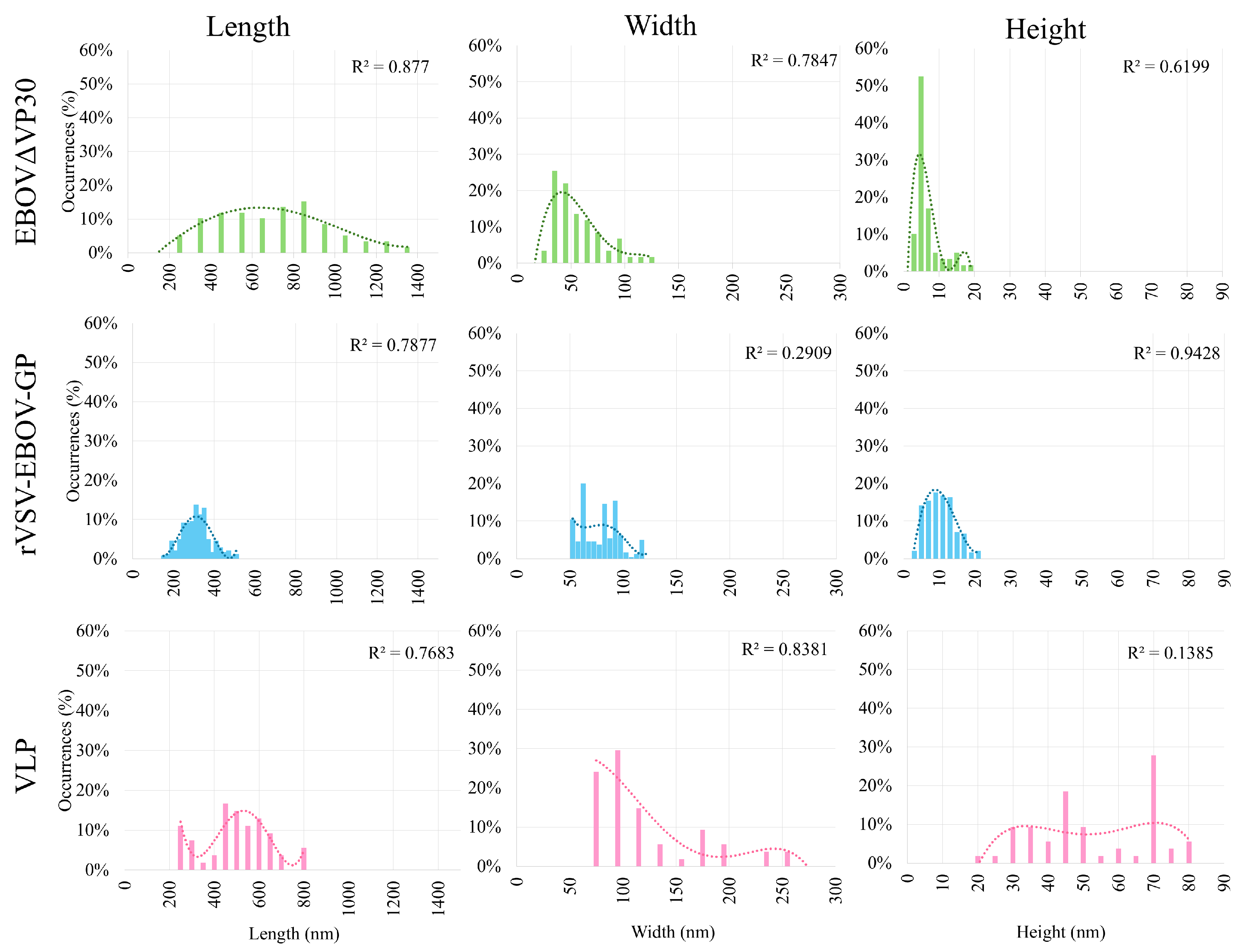

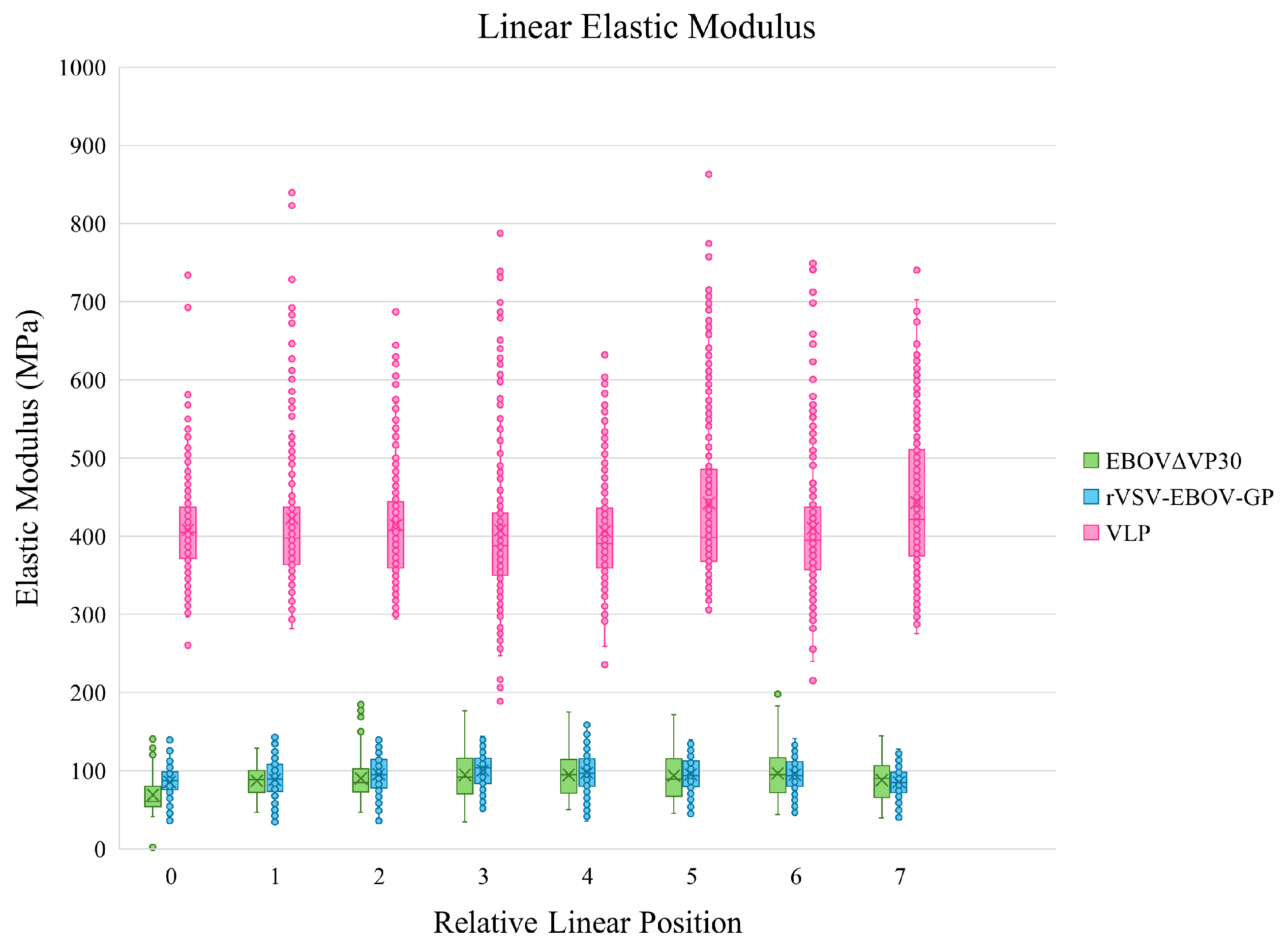

| Sample | Length (nm) | Width (nm) | Height (nm) | Elastic Modulus (MPa) |
|---|---|---|---|---|
| infectious EBOV * | 805 | 80 | 80 | – |
| EBOVVP30 | 531.4 ± 264.6 | 42.6 ± 22.6 | 3.85 ± 3.53 | 100.4 ± 51.5 |
| rVSV- EBOV-GP | 285.3 ± 74.6 | 70.4 ± 20.3 | 7.4 ± 4.2 | 93.5 ± 22.3 |
| Sf9 EBOV VLP | 480.2 ± 152 | 115.1 ± 55.5 | 51.5 ± 18.9 | 420.0 ± 87.8 |
| Sample | Number of Imaging Scans | Number of Nanoindentation Force Curves |
|---|---|---|
| EBOVVP30 | 59 | 7242 |
| rVSV- EBOV-GP | 204 | 1972 |
| Sf9 EBOV VLP | 54 | 2531 |
Disclaimer/Publisher’s Note: The statements, opinions and data contained in all publications are solely those of the individual author(s) and contributor(s) and not of MDPI and/or the editor(s). MDPI and/or the editor(s) disclaim responsibility for any injury to people or property resulting from any ideas, methods, instructions or products referred to in the content. |
© 2025 by the authors. Licensee MDPI, Basel, Switzerland. This article is an open access article distributed under the terms and conditions of the Creative Commons Attribution (CC BY) license (https://creativecommons.org/licenses/by/4.0/).
Share and Cite
Hargrove, H.; Torres-Hurtado, S.A.; Maury, W.J.; Zhang, X.F. Nanoscale Mechanical and Morphological Characterization of Ebolavirus-like Particles: Implications for Therapeutic Development. Int. J. Mol. Sci. 2025, 26, 5185. https://doi.org/10.3390/ijms26115185
Hargrove H, Torres-Hurtado SA, Maury WJ, Zhang XF. Nanoscale Mechanical and Morphological Characterization of Ebolavirus-like Particles: Implications for Therapeutic Development. International Journal of Molecular Sciences. 2025; 26(11):5185. https://doi.org/10.3390/ijms26115185
Chicago/Turabian StyleHargrove, Hannah, Susana A. Torres-Hurtado, Wendy J. Maury, and Xiaohui Frank Zhang. 2025. "Nanoscale Mechanical and Morphological Characterization of Ebolavirus-like Particles: Implications for Therapeutic Development" International Journal of Molecular Sciences 26, no. 11: 5185. https://doi.org/10.3390/ijms26115185
APA StyleHargrove, H., Torres-Hurtado, S. A., Maury, W. J., & Zhang, X. F. (2025). Nanoscale Mechanical and Morphological Characterization of Ebolavirus-like Particles: Implications for Therapeutic Development. International Journal of Molecular Sciences, 26(11), 5185. https://doi.org/10.3390/ijms26115185







